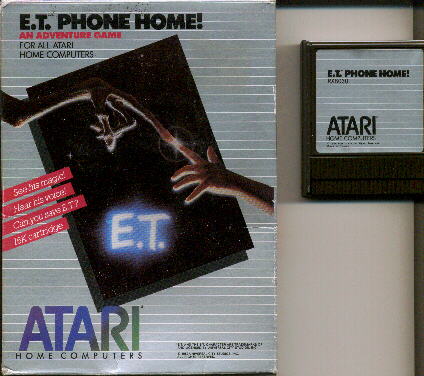newMedia(now&&then)
Sunday, February 06, 2005
E.T. ++ C-1 -= artware.rom ++ artworld.emu

//i sent the follwinig post thru to -empyre-
//the archiving month is off to a great start
//++ the discussions are flowing + inspiring.
From: joncates@criticalartware.net
Subject: Re: [-empyre-] emulation and multiple nodes as archive method
Date: February 6, 2005 12:06:33 AM CST
To: empyre@lists.cofa.unsw.edu.au
Reply-To: empyre@lists.cofa.unsw.edu.au
On Feb 4, 2005, at 6:08 AM, Jason Nelson wrote:
>To begin: a brief antidote: Those children of the
>eighties, who so loved cartridge Atari and the first
>Nintendo and couldn't find reliable old machines,
>programmed emulators to play them and now these games
>live on and continue expanding their cultural imprint.
another notable approach is hardware specific, such as the [current/commercial] Atari® Flashback™ Classic Game Console that combines games from the Atari 2600™ + Atari 7800™ platforms as well as a previously [unreleased/unearthed] “classic” (postmodern quotes provided by Atari copy writers) game called Saboteur™.
which reminds me of the time criticalartware core.dvrs met @ the home of jon.satrom before launching the beta version the criticalartware applat in 2003 + played E.T. on the Atari 2600, discussing archiving, logging + capturing, collecting + preserving artware, video + new media. we played E.T. (which jon.satrom is very good @ btw) + discussed how the game is [blamed/faulted] for ruining the Atari b/c of it's economic failure. gameplay in E.T. involves reconstructing the E.T. Phone by searching for + finding [pieces/components] of the device while navigating pits that E.T. falls into. this gameplay is especially relevant b/c millions of copies of the E.T. game cartridges were buried in a giant cement covered pit in Alamogordo, NM .US. the cartridges were buried towards the end of September 1983 when the E.T. game failed to sell as well as expected + Atari itself was failing economically. we discussed this broken (cartridges were crushed before the cement was laid) + buried archive as a kind of model failure + romantic fantasy for us as "children of the eighties".
E.T.'s "Phone Home!" mantra of nostalgic yearning for {return|reunion} interbreed w/conspiratorialHystories, early July 1947, Roswell NM .US, UFOs + extraterrestrials creating the possibility of an alien discovery of the Atari E.T. archive. if this discovery were to occur after the end of human life on earth, reconstructions of the game could provide a unintended [recording/messaging] system of human hystories. or @ least these were among our playful speculations + became a part of our decision to focus on creating discursive [spaces/possibilities] w/in criticalartware via Liken + only archive directly in relation to those discursive [functions/features].
this also reminds me of a recent conversation the criticalartware core.dvrs had wherein we were talking about the all-in-one joystick-based systems that are available now + BenSyverson noted the activity surrounding the work of Jeri Ellsworth. Jeri Ellsworth (also a "child of the eighties") has recreated the entire Commodore 64 on a chip encased in a joystick w/the standard all-in-one approach of audio-video outputs but also allowing for keyboard, disk drive + monitor to be attached in order to encourage development on this compacted version of the C-64 platform. her approach enables new generations to begin to {play|program} w/the C-64 + opens the system to wider uses + more [flexible/portable] applications.
>It seems the most powerful archiving tool is people
>loving and owning whatever work it is you want saved.
abs == yes.
>If there are fifty thousand copies of something
>floating around and the devices used to view/play it
>are obsolete, then at least a few of those people will
>create an emulator. Then that emulator and the work it
>plays will be passed around again.
very true.
this also raises the issue of the legality of emulation, specifically in regards to ROMs, backups as archives, licensing vs. ownership, reverse engineering, etc... often these lovingly made + shared emulators + ROMs involve vaguely if not directly extralegal activity. this is (of course) 01 of the reasons companies such as Atari are offering commercial products of classic bygone platforms. the corporations have realized that a market has been created by the aging generations of gamers + younger gamers who run emulators. Nintendo has been particularly aggressive in stopping the development + distribution of emulators for obsoleted games + platforms as well as the sale of materials that can be used for development on those platforms. aggressive + heavy handed corporate [strategies/policies] limit the ability of [artists/developers] in the home-brew or hobbyist communities to easily access the [technologies/systems] needed to develop [uses/applications] of these commercially obsoleted {hard|soft}wares. confronting a paradigm of control such as this can put [artists/developers] in hazily defined or clearly extralegal situations, however, this activity is required if 01 is to confront planned obsolescence + to {creatively misuse|hack} devices + applications that are in our shared cultural experience.
>So perhaps what should be done, at least in the case
>of areas such as digital music, net art, software art,
>web page archiving is that we should offer the work
>for free. Give people the chance to download work,
>make it their own. Also provide people with space to
>set up their own archives of work, or support those
>digital communities which would create emulators. A
>multi-nodal archive would be much healthier and
>dynamic.
abs == yes!
offering the work for free or under various open licensing schemes (such as Creative Commons) [artists/developers] can encourage experimentation, assist archival projects, avoid the limitations + economics created by corporate models of ownership + address consumption, capitalism + control structures that operate governmentally (i.e. the DMCA in the .US) + socially (i.e. the artworld [models/economics] of artificial scarcity + perceived value]).
it seems to me that decentralized multi-nodal vasty tingleTangles could create self-supporting safety.nets that would also connect w/institutional projects + endeavors functioning as nodes + allowing for varied approaches to sustain each other.
as the discussion has already clarified in the last few days, archival approaches to the same digital worlds create very different world views, as is to be expected. the coexistence of these worlds as construct parallel hystories that can healthily [complicate/problematize] illusions of totality, objectivity or absolute validity in hystorical projects such as [these/ours].
[talk/type] soon...
// jonCates
edu: http://www.artic.edu/~jcates
collab: http://www.criticalartware.net
projs: http://www.systemsapproach.net
_______________________________________________
empyre forum
empyre@lists.cofa.unsw.edu.au
http://www.subtle.net/empyre
Archives
CONTACT:

CONNECT:
![]()
![]()
![]()
![]()
POSITIONS:

![]()

![]()

![]()
![]()
![]()




WAREZ:
![]()
![]()
![]()
![]()
![]()

![]()






